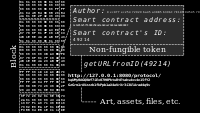
Photo from wikipedia
according to the Merriam-Webster dictionary, a non-fungible token (NFt) is,” a unique digital identifier that cannot be copied, substituted, or subdivided, that is recorded in a blockchain, and that is… Click to show full abstract
according to the Merriam-Webster dictionary, a non-fungible token (NFt) is,” a unique digital identifier that cannot be copied, substituted, or subdivided, that is recorded in a blockchain, and that is used to certify authenticity and ownership (as of a specific digital asset and specific rights relating to it).” as noted by Kim (2021), in recent years, Gucci, Coca-Cola and other marketers began using metaverse platforms such as decentraland to sell nonfungible tokens (NFts). to date, most NFts have involved works of art, images or representations of a product, video, audio, or some combination of the above. there can be little doubt that some early efforts at selling NFts have been related to an effort to appeal to affluent younger “digital natives” who are viewed as trendsetters (duma et al. 2016; Kirjavainen 2022). indeed, sales of NFts have been growing (Kirjavainen 2022). However, academic research on NFts as a promotional tool has been scarce (taylor 2022). While it appears that, to date, NFts have not yet produced large revenue streams for marketers in comparison to sales of physical products– owing in part to uniqueness and scarcity being part of their appeal, it will be interesting to see what the future brings in terms of applications. Yanie durocher, founder of PoMPoM creative sees immense potential for double wardrobes, meaning consumers having both physical and digital wardrobes, or “skins” (durocher 2022). durocher also notes the potential for exposure to hundreds of thousands of consumers via a social media outlet such as tiktok, arguing that the digital version can influence purchases of physical product. to date, however, the biggest success stories seem to be highly creative promotional activities that are more likely to pay off in terms of promoting the brand and building/reinforcing brand associations that create brand resonance. For example, rather than simply selling NFts to the highest bidder, louis Vuitton’s “louis: the Game” which now has had more than two million users has users search for postcards that actually NFts, and some of which are scarce. Participants can also solve puzzles for the right to be entered into a raffle that offers prizes in the form of NFts featuring the game character Vivienne in a form that can be used in online profiles. Nike is also doing something quite creative around its new Swoosh Web3 and NFts. the company is offering a collection called our Force 1 (oF1) virtual sneaker NFts that pay tribute to the 41-year-old air Force 1 shoe. Users can access and purchase Classic remix (older) sneaker boxes or New Wave (new boxes) for $19.82 USd. While the initiative may generate significant revenue, the broader impact on the brand is particularly interesting. While it is difficult, if not impossible, to predict all future directions applications of NFts will take, it is clear that marketers are using them, and that in some sectors, especially luxury and fashion products they have become important promotional tools. as a result, at the current time, some questions in need of research are:
Journal Title: International Journal of Advertising
Year Published: 2023
Link to full text (if available)
Share on Social Media: Sign Up to like & get
recommendations!